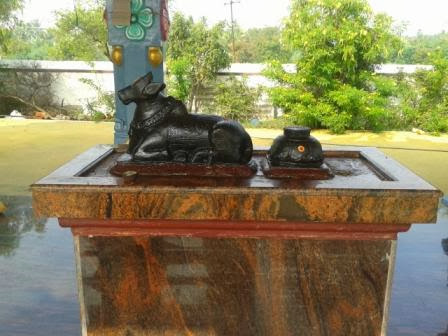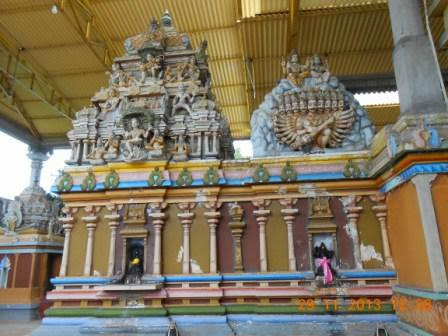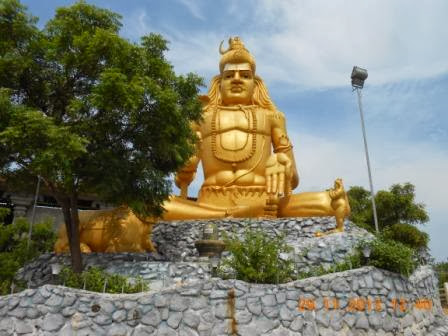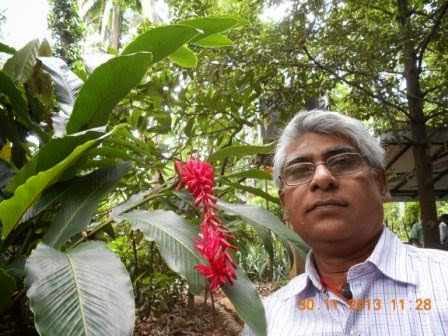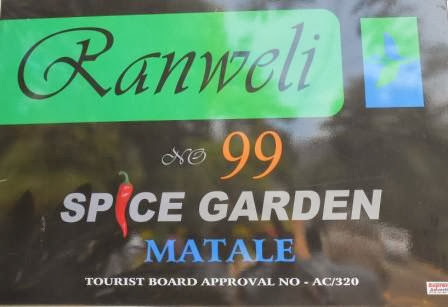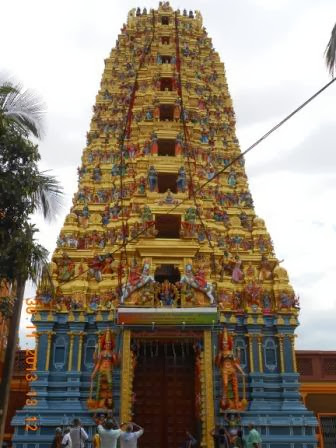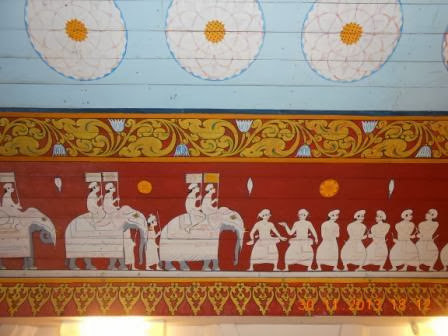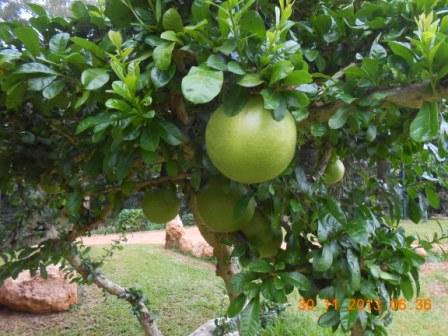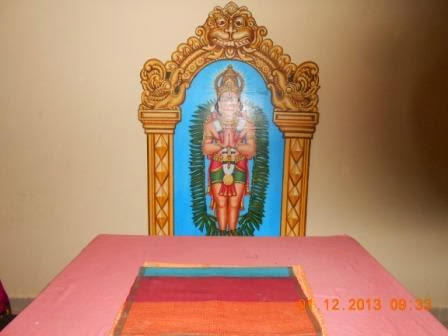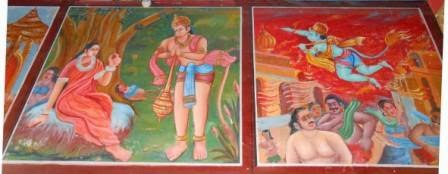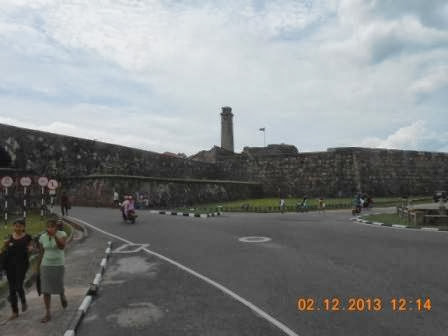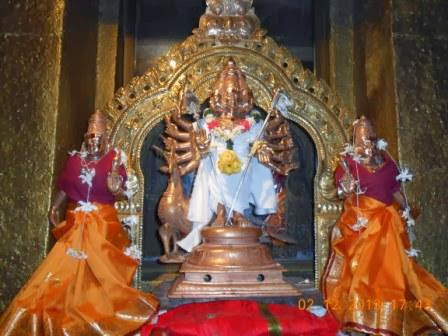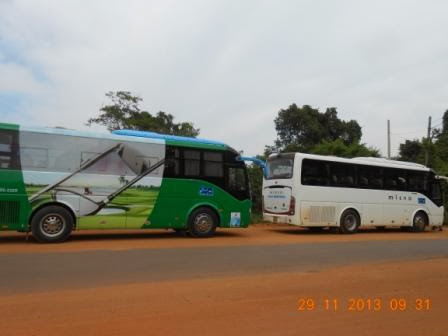6, December 2013
Since I have completed the darshan of 274 Devaram
Paadal Petra Sthalangal and would like to cover the balance of 2 Shiva temples in
Sri Lanka also. My ambition of do the darshan of all the SRI LANKAN yathra.
28-11-2013, THURSDAY, FIRST DAY.
I was more anxious about the SRI LANKAN yatra
between 28-11-2013 to 02-12-2013, so could not sleep well on the 27th night.
Reached Chennai airport and joined with Super Yathra Agencies, of Kumbakonam to
catch the flight to Sri Lanka. (M/s Super Yathra Agencies, in
turn, has arranged this visit through Srilankan Holidays, a Travel Agency
in Sri Lanka and Chennai. Mr Denzil, our Guide explained Sri Lanka’s
History, Culture, Politics, Economy, Education, Religion, Business, etc.,
during the bus journey. The details are written at the end of this
article). It was a 5-day visit to Sri Lanka. After completing all the
formalities we boarded the flight, which took off around
07.30 Hrs from Chennai Airport. My long ambition came true when I
landed in Colombo, Sri Lanka on Air India Flight on the 28
Coming out of the Airport at Colombo - Mr. Siddque of Super Yathra Agency leads the group
AIR INDIA flight takes off from Chennai - CLICK HERE
The train route to Mannar is under reconstruction after removing the
land mines laid by the LTTE. We could not see the people's movement on the road.
On the roadside shops were open but nobody was there to buy. The name boards
were written in Sinhalese, Tamil, and English.
We are lucky enough to join the evening pooja after traveling a
distance of 215 km from Colombo Airport. There was not much crowd in the
temple. Regular poojas are conducted as per agamam. The river Palavi is
very near. Once it was a river and now like a pond and the water will be used
to do abhishekam to Mahalingam during Maha Shivaratri.
274 / 2. SRI THIRUKETHEESWARAM TEMPLE,( திருக்கேதீச்சரம் )
This is the 274th Paadal Petra Shiva Temple in Sri Lanka.
Moolavar : Sri Thiruketheeswarar
Consort : Sri Gowriambal.
Some of the important features of this temple are …...
The temple faces east with a 5-tier Rajagopuram. Balipeedam, Rishabam, and Dwajasthambam are in front. At the entrance of Rajagopuram, the Rishabam is an old one, and Ganapathi and Subramaniyar sannadhis. Adhikara Nandhi is on the left side of Rajagopuram.
In the inner praharam sannadhi for Suryan, Storage place, Yaga salai, Thirugnanasambandar, Kethu, Santhanasiriyars, Thirumaraikal, Chatur Vedas, Urchava murtis of Nalvar, Sekkizhar Peruman, 63var, Sundarar. Next is Vinayagar, Somaskandar, Vishnu, Mahalingam (He was once a moolavar who was damaged during excavation), Subramaniyar, Deva Saba, Saraba Moorthy, Nataraja Peruman, Yaga salai, Bairavar, Saneeswaran, Chandran.
Navagrahas are in a Nirutha mandapam. Ambal Sri Gowri Ambal is facing south. Malaysia Tamilars, Yazhpanam Periyava Vasuvappa, Ponnili Udayar, Arulambalam, Mannar Asst Govt official Arumugam are responsible for thirupani to this temple. The temple has 5 Chariots, of which Moolavar’s is big.
There are lot of madams on the east street some of them are Thirugnanasambandar madam, Sundarar madam, Nattukottai Chettiars madam, Amma madam, Pasumadam, Poonagariyar madam, on south street Swamy madam, Sivarathri Madam, Nesavu madam, Sthapathis madam, on the west street Gurukula madam and on North street Navalar madam, Vishwakarma madam, Thirukkuripu Thondar madam, Annadhana mandapam.
HISTORY
This temple is in the north part (North Province) of Sri Lanka at Maanthai
alias Maathotta nagar on the banks of Pallavi river ( Now it has become like a
lake )near Mannar. Once it was a port, used for business by the
Greeks, Romans, Arabians, etc,. Maha Dhuvatta a deva thachan worshiped Lord
Shiva of this temple, hence this place was called Mahadhuvatta Puram and
later called Mathottam. Also, Manthai originally came from Maha
Sandhai (மகா சந்தை - a daily weekly monthly, or yearly held marketplace called sandhai)
The temple was completely destroyed by the Portuguese and was
reconstructed later. Next to this are the Pappa Mottai, Maaligai
Thidal, Vettaiyamurippu, Kovilkulam, Paddy field, Coconut trees, etc,. During the Chozhas Period, Chozha King Rajarajasekaran’s son Rajendran called
this place Arunmozhithevan Valanadu. Also called Manthottathu
Rajarajapuram. The Place Pappamottai once was a raised land occupied by the
Brahmins who had done pujas to this temple and the
Vettaiyamurippu was used for conducting Thirukethareeswarar’s Vettai
thiruvizha.
The inscriptions from the old temple site tell us the Chozha’s contribution to this temple. In addition to this, the inscriptions at Chidambaram
temple also throw some light on the thiruppani done by the
Pandya King Sundarapandian to this temple.
The temple was once under the control of Chingaiyaria Kings
who also controls the Rameswaram of Tamil Nadu.
Even though the temple was destroyed the moorthams
were safely buried under the earth. This was informed by Sri la
Sri Arumuga Navalar who lived in the year 1872, through bit notices
and he was instrumental in bringing out of the temple details to
this world after it was destroyed.
The temple is constructed on 43 acres of land through an open auction
for Rs 3100.00 by Thiru Rama. Aru. Palaniappa Chettiar from the British
Governor U Willams Duvanaima Durai in a postponed 2nd time auction on
13-12-1893 (The first time went up to Rs 3050, which the Saivaites could not
mobilize the money and was asked by Christians).
The important people involved in the reconstruction of this temple are
Palaniappa Chettiar, Pasupathi Chettiar, and Neeraviyadi Vai. Arumugam, Vaithiyar
Ramu Pillai, Raghava Pillai from Tamil Nadu and Latter for thirupani
Somasundaram Chettiar (1952) of Kulasekarapattinam,
During reconstruction, the old sanctum sanctorum,
Artha mandapam, Balipeedam, and Dwajastham installed places were unearthed. Damage
occurred for the moola Lingam ( Maha lingam ) during excavation was installed
in the praharam. The estimated cost of the temple was Rs 22000 for moolavar and
Ambal sannadhis.
Kumbhabhishekam was performed in 1903, 1910, 1948, 1956 (Sri Somasundaram Desikar, Madurai Aadheenam, and Polioli Sivapatha
Sundaram are responsible), 1960 (Sri la Sri Arumuga Navalar’s student Kasi vasi Senthilnatha Iyer with the help of
Tamil Nadu’s Sthapathis Tirupati), 1971 and 1976 in various
stages.
From 14-09-1956, the responsibility of maintenance of this temple
was transferred to Eelam Sivanadiyar from Nattukottai Chettiars. But still, Chettiar participation is there.
The Somaskandar is the largest in the world and was made at
Ketheeswaram itself. The idol was made of panchalogam (5 metals) of which nearly
112 grams of gold had been added.
The biggest Somaskandar in the world ( 112 grams of gold was added while making )
For this temple’s Devara Thirupathigam meanings are written by Sri
Ponnambalam Pillai, the son-in-law of Sri la Sri Arumuga Navalar.
(The Details were taken from the Temples' book released during the recent
Kumbhabhishekam, Paadal Petra sthalangal details book written by Thiru Pu. ma.
Jaya Senthilnathan of Kanchipuram Sankara Mutt and during the actual visit to this
temple).
LEGENDS
The Lord was worshiped by Kethu, Maha Dhuvatta, Sri Ramar, Agasthiyar, and Ravanan. Since Kethu was worshiped, the temple was called Thiruketheeswaram.

Moolavar vimanam
Rishabam Mandapam
Maha
Lingam ( This is the original one. This was damaged during excavation and
hence installed in the praharam )
We could not see many houses near the temple. Since we were running short
of time we could not go around the temple and also had to travel to
Anuradhapura where we had to stay at Hotel Mirinday for the next day’s travel to
Thirukonamalai.
29-11-2013, FRIDAY, SECOND DAY.
The second day’s journey was a tough one and the total distance covered
was 488 KM both up and down. The reconstruction of the road from Anuradhapura
to Trincomalee is in progress after removing the land mines laid by LTTE
during the war.
The temple is on a small hill near the seashore. The bus dropped us at
the base of the temple. A fort was built around the temple by the Portuguese
after destroying the temple. Most of the people preferred Auto and a few people
climbed up the hill along with me enjoying the beauty of nature. We could
see a lot of military people's movement on the road. Reached the Temple around 11.45 Hrs.A Poster of the temple at the entrance
273/1. KONESWARAM TEMPLE, THIRUKONAMALAI
( Trincomalee- திருக்கோணேச்சரம் திருக் கோணேச்சரம் கோயில் )
This is the 273rd Paadal Petra Shiva temples in Sri Lanka.
Entrance to the temple with Rajagopuram on the north side
Moolavar : Sri Thirukoneswarar
Consort : Sri Mathumayal
Some of the important features of this temple are...
The temple faces east with a 3-tier Rajagopuram. Artha mandapam,
Snapana mandapam, Vasantha mandapam, Yagasalai and
Pagasalai are in the temple as per agamam. In Snapana mandapam Sri
Sivakama Sundari Sametha Sri Natarajar.
View of moolavar from Dwajasthambam
In Deva Saba, panchaloha moorthams of Sri Valli Deivanai
Sametha Sri Subramaniar, Somaskandar, and Chandrasekar are worth seeing. In the Prakaram moorthams of Suryan, Chandran, Naagar,
Bhairavar, Chandikeswarar. Kasi. The present temple was
reconstructed as per Aagamam. The old idols of Sri Mathumayal
sametha Sri Koneswara, Chandrasekar, Parvathy,
Pillayar, and Asthira Devar taken from the wells and ponds were
reinstalled. (This was found out when the Govt.
authorities while excavating a well).
HISTORY
This temple has a history of 3287 years. This place was originally
called Thirikooda. During that period there were three temples one on
the hilltop, one in the middle, and a third at the base of the
hill. The old temple was destroyed by the Portuguese after taking
the drawings of Vimanas and Rajagopuras. I was told that the drawings are
still available in the Visben (Lisbon ?) museum.
The idols were saved by the devotees and dropped
in the wells and ponds to be taken out in the latter period during the Portuguese war. New temple reconstruction was started after independence in 1950 and
Shiva Lingam was brought from ). The temple has land for burning lamps with ghee and the
Lotus thread was used.
This temple is situated in a beautiful atmosphere with
good water springs and near the sea bay of Bengal.
Service institutions with residences are around the temple.

Entrance to the fort
The History of the Fort
Banyan trees
Direction board to the temple
banyan tree is swallowing the Palm tree
Blackbuck Deers are grazing
The guns may be used by LTTE
Stucco image of Lord Shiva
Ambal Sri Mathumayal Sannadhi
Natarajar Saba
West side Rajagopuram
Utsava Idols
History of the temple
Stucco images around Kal alamaram/Banyan tree, grown on the rock)
Ravana worshiping Lord Shiva - A stucco image
As
planned we could not see the Bhadrakali Amman Temple (Built during the 11th century
by the Tamil King Rajendra Chozha), so we proceeded to Anuradhapura. On
the way, we went to KANNIYA Hot Water Springs. (Once it must be a volcanic
activity place). It was believed that these 7 hot water springs/wells were
created by Ravana for his mother's last rites. The water in the well has different
temperatures. The first one with a high temperature and the last one will have a lower temperature.
Kanniya Hot water springs.
The Seven Hot Water Wells
Also, we had seen a dilapidated structure partially
excavated. It was said that the structure was built by two Kings who ruled that
place. Since the structure is adjacent to the hot water wells, the structure
might have been used to do the last rites. We could not find any inscriptions.
The excavated dilapidated structure
Also, there is a Shiva Lingam housed in a building, constructed
recently. (The Shiva Lingam must be an old one and might have been taken from the
dilapidated structure). Reached Anuradhapura Hotel around 19.30 Hrs.
30-11-2013, SATURDAY, THIRD DAY.
Continued
our third-day journey From ANURADHAPURA to KANDY.
Arulmigu Kathiresan Kovil / Kathiresan
Temple/ Kadireshan Kovil / அருள்மிகு
கதிரேசன் கோவில், Anuradhapura, Sri Lanka.
First, we went to a Murugan temple. There is no main idol, instead a Spear / Vel is installed. In praharam Vinayagar, Murugan, Nagar, Lakshmi, Navagrahas, Natarajar Sabha.
Front tiles roof mukha mandapam
Our group
Moolavar Vimanam
Sannadhis in the prakaram
Dambulla Royal Cave Temple and Golden Temple / Buddhist Temple, Dambulla, Sri Lanka.
On the way, we had been to DAMBULLA a Buddhist temple. This temple
was built during the First century and has
5 caves with paintings like Ellora and Ajanta, in India. Due to
short of time, we have not been inside.
On the way to Kandy, we visited the Ranweli
spice garden at Matale, where a lot of spices were grown. There were about 23
varieties of medicinal plants. It was believed that a piece of Sanjeevani hill
was fallen down, while Hanuman brought from Himalayas to cure Lakshman (Rama). Guides explained the benefits of spices and medicinal plants. Massages
are done using the herbs (free and sample). We had our lunch at Matale Spice
Garden restaurant.
Jathi kai with Jathipathri.
Coco
Ladies are playing drums to entertain the tourists
Name Board
Sri Muthumari Amman Kovil / ஸ்ரீ முத்துமாரி அம்மன் கோவில் – மாத்தளை / Matale, Sri Lanka.
After Lunch at Matale Spice Garden
Restaurant we went to Sri Muthumariamman Temple. This temple has a 9-tier
Rajagopuram with a magnificent view. Kumbhabhishekam was performed recently.
Most of the Stucco images were done by Tamil Nadu Mamallapuram
Sthapathis. The history of the temple goes like this. During British rule, Tamil
people from India were brought to Sri Lanka to work in the Tea Estates
with a heavy workload. People were accommodated in a cramped shelter. Due
to unhygienic conditions, people got measles. Then they worshiped
Muthumariamman and got cured. To thank for relieving from the disease they
constructed this temple and expanded later.
West side entrance
The 9 tier Rajagopuram
The 9 tier Rajagopuram
South side entrance
View of the temple complex
Sri Somasundareswarar Temple / Pillaiyar
Kovil, Kandy, Sri Lanka.
Moolavar : Sri Soma Sundareswarar
Consort : Sri Meenakshi
The important features of this temple are….
The Rajagopuram is of 5-tiers with a magnificent
view. Nandhiyam peruman in silver kavasam, which is unique in this temple. Balipeedam, Dwajasthambam and nandhi are after the rajagopuram. In
koshtam Dakshinamurthy, Lingothbavar, Brahma, and Durgai.
In the inner praharam Bhadrakali Amman, Naalvar, Kalyana Venkatesa
Perumal, Maha Ganapathy, Somasundarar, Rajarajeswari (Urchavar), Kasi
Viswanathar, Visalakshi, Pancha Lingam, Maha Lakshmi, Arumuga Swamy, Navagrahas ( In sitting posture), Thillai Chirsabai.
In Mandapam sannidhi for Dhandayuthapani, Selva Vinayagar, Panchamuga
Vinayagar, Meenakshi Ambal and Palliyarai.
In mandapam paintings belong to Vinayagars. The temple and mandapam
are built with stone by Nattukottai Chettiars.
The 5 tier Rajagopuram
Pancha mukha Lingeswarar
Thillai Chitrambalam
Vinayagar - Urchavar
Nandhiyam Peruman after abhishekam
Sri Dalada Maligawa, A Buddhist Temple, Kandy, Sri Lanka.
After the darshan of Lord Sri Soma Sundareswarar, we
went to a Buddha Temple – Sri Dalada Maligawa, Kandy. The temple has the
relic of Buddha’s teeth. The relic was kept at the center of the building
on the first floor, which is made of wood with intricate carvings. There are a lot of
paintings and Murals. One such painting was about the function of getting rain.
Persons with whip/chavukku, fire lamps, Srilankan nadhaswaram, and drums, Elephants with relics go in procession. This signifies the Thunder, Lightning, wind, and rain clouds (Elephants). The river Manavali flows around the city of Kandy. The meaning of Kandy is Sanyasi City. (Kandy – Senkatapura, Senkata =
Sanyasi, Pura = City). After visiting Buddha’s relic–teeth temple stayed at
Hotel Senani, Kandy. It was interesting to note that Buddha had visited three
times to SRI LANKA.
Entrance to the Buddha's temple ( Security check will be done here )
View during Night - a beautiful lighting view
Sinhala music is being played before opening the shrine
The Architecture of the central mandapam where Buddha's relic is being kept - see the beauty of the mandapam kodungaikal
Painting of Buddha's relic was carried hidden in hair by the princes Hemamali and her husband prince Dantha.
Painting of Buddha's relic was carried hidden in hair by the princes Hemamali and her husband Prince Dantha.
Some of the paintings
Some of the paintings
Some of the paintings
Painting of the temple 1891 CE
We had stayed at Hotel Senani. The garden at the hotel was
maintained beautifully.
01-12-2013,
SUNDAY, FOURTH DAY
From KANDY we proceeded to KATARAGAMA (
Kathirkamam ). On the way, we crossed the City of NUWARA ELIYA. This means City
of Lights. Tea and rubber plantations are the important activities in this
place. This place is also called Little England, where British people
stayed here during summer.
On the way we saw the waterfalls
called Ravana Koda (Thawalanthenna). It was believed that Ravana had
taken a bath in these waterfalls.
Then
we went to the Hanuman Temple on a small hill. The temple is about 2.5 KM off the main road. Due to short of time, we are advised to go by AUTO to Hanuman temple.
The temple is being maintained by the Chinmaya Mission. The Hanuman might be about
20 feet tall. It was believed that Hanuman visited this place first in search
of Seetha. Special poojas are conducted every full moon day. On the base of
this hill, there is a small Vinayagar sannidhi called Sri Varadharaja
Vinayagar.
SRI
RAMA BAKTHA HANUMAN TEMPLE
 |
Sri Varadharaja
Pillayar - at the base of the foothill
|
Hanuman Painting on the basement floor
A beautiful mountain view
After Hanuman’s Darshan, we had been to GAYATHRI
PEEDAM at NUWARA ELIYA. Also called Gayathri Siddhar Peedam. There are 108 Bana Lingas brought from the Narmada River of India, are waiting for installation.
It was believed that The Lingams are growing day by day due to regular poojas
and sweating also appears on the banam. The Peedam was founded by Sri Sri
Murugesu Swamigal and managed by his disciple Sri Kannaya Swamikal.
It was believed that Ravana’s son Meganathan (Indrajith) had done dhabas at this place to get victory for his father. To
acknowledge his dhabas mummoorthigal came to this place and blessed him. (
In spite of this Ravanan was defeated by Sri Rama is the real story).
SRI GAYATHRI PEEDAM at NUWARA ELIYA.
Moolavar : Sri Mrityunjaya Devan
Consort : Sri Gayathri Devi (
with five faces in a sitting posture )
In the mandapam idols /sila roopam of Mummoorthigal (Shiva, Brahma and Vishnu) along with Sri Vinayagar. In Gayathri Devi’s
sannadhi Koshtam, Sri Rama Gayatri, Vishnu Gayatri and Krishna Gayatri.
There are separate sannadhis for Sri Agasthiyar and Vishwamitra.
It was interesting to note that regular classes on
Arulneri for the Tamil students on Sundays are being conducted from 08.00 Hrs
to 12.00 Hrs. Saiva samayam, Nayanmars, Devaram, and Thiruvasagam are taught to the
students. ( Really great indeed).
Entrance to the main shrine
Shiva, Brahma, and Vishnu
Agasthiyar
Vishnu Gayatri
After
lunch, we went to SEETHA ELIYA – Seetha Amman Temple. In the main sannadhi
both marble and Stone moorthams of Anjaneya, Lakshmanan, Ramar, and
Seetha. There is a separate sannadhi for Anjaneyar. Guide showed us the
footprint of Anjaneyar on the river bed. In the mandapam, there are painting of Ramayan Story.
SRI
SEETHA AMMAN TEMPLE
Entrance from the side - Road at a higher level
Moolavar Vimanams
Moolavar Vimanam
Lakshman, Ram, and Seetha (Marble and Stone moorthangal)
Hanuman Sannidhi
Paintings of Epic Ramayana story
Paintings of Epic Ramayana Story
Hanuman's footprints.
Ashoka vanam where Sita was kept
Our
previous plan was to have the darshan of Kathirkamam Murugan on the fifth day.
Since we had to travel a long distance on the fifth day decided to
have the darshan on the fourth day itself. So we straightaway went to
KATARAGAMA (KATHIRKAMAM) Periya Kovil. A Buddha sannadhi was also constructed
on the left of Sri Vinayagar Sannadhi. The details are as follows.
Ruhunu Maha Kataragama Devalaya,
(Kathirkamam) Periya Kovil, Kataragama, Sri Lanka.
In the
main shrine sannadhi for Buddha, Vinayagar, and Sri Murugan.
On the
right side separate sannadhis for Vishnu Koil, Bhairavar, Deivanai, and Guru peedam where we can see the 7 Siddhar jeeva Samadhis.
Valli
Sannadhi, Bhadrakali Amman, and Sivan sannidhi are opposite to the main shrine.
It was
believed that there were no idols/murtis inside the sannadhi and we had to worship
the screens printed by the respective gods. ( Some people said that there is a
chakram and soolam inside and poojas are conducted for that. )
In the
Murugan temple large-sized pictures of Sri Valli, and Deivanai with Murugan
marriage. Once in a year Lord Murugan will come out and marry Valli near Valli
Sannadhi. That time also Murti will not be visible. Will be completely covered
with flowers.
The night
pooja is being conducted by Muslims (Do not know the reason)
The
hunter people are given importance in this temple since Valli belongs to
Veduvar kulam (Hunters).
In the
entrance arch neon light is written as KATARAGAMA PERIYA KOVIL (The direction
sign board also says that Ruhunu Maha Kataragama Devalaya).
Direction board
Entrance arch to the Kathikamam Murugan Temple
Sri Murugan Sannadhi
Buddha's sannadhi
A Big Peepal ( Bodhi tree )
Must be Shiva Lingam
Valli's sannadhi
Valli is standing under the tree
Shiva Temple
The man in blue is Mr Srinivasan of Samrat Travels who had arranged for Kailash darshan
02-12-2013, MONDAY, FIFTH DAY.
Today
is the last day in Sri Lanka and we have to travel a long distance to reach
Colombo. We have traveled along the seashore. On the way, we spent some time
at Galle Beach. The tides were very high due to the No Moon Day. We had seen many
people surfing on the tides.
Galle beach
Video Taken at Galle Beach to see: CLICK HERE
Also, we have crossed the Galle Fort constructed by the Dutch (This is the place where Thiruchendur Idols are Kept, which are stolen by the Dutch). And
opposite to that there is a Cricket stadium
From Galle to Colombo we traveled through Express Highway
with a speed of 100 km per hour. The road was very good and we are able to
cover the distance of 110 km in an hour. The traffic is very minimal and we
could not see any lorry movement. There is no intersection of roads throughout
the stretch. Sitting on the bus we saw the Parliament, Parks, and
corporation building (Like the White House of the USA).
Convention hall
White House - Corporation Govt Building
A Park
From Galle to Colombo we traveled through Express Highway
with a speed of 100 KM per hour. The road was very good and we are able to
cover the distance of 110 KM in an hour. The traffic is very minimal and we
could not see any lorry movement. There is no intersection of roads throughout
the stretch. Sitting on the bus we saw the Parliament, Parks, and
corporation building ( Like the White House of the USA ).
Before going shopping we went to Sri Ponnambala Vaneswarar temple.
The temple was built about 150 years ago by Nattaukottai Nagarathars. Mr
Ramanathan is one of those involved in the construction of this temple.
Sri
Ponnambalawaneswarar Devastanam Kovil, Kotahena, ஸ்ரீ பொன்னம்பலவனேஸ்வரம் கோவில். கொட்டாஞ்சேனை ශ්රී
පොන්නම්බලවානේස්වරර් දේවස්ථානය,
කොටහේන, Colombo, Sri Lanka
Moolavar : Sri Swarna Sabeswarar swamy
Consort : Sri Sivakami Ambal
Some of the important details of this temple are …..
The Rajagopuram is of 5-tiers. Balipeedam, Dwajasthambam and Rishabam are
in inner praharam. In Koshtam, Vinayagar, Dakshinamurthy, Lingothbavar,
Brahma and Durgai.
Sannadhi for Moola Vinayagar, Somaskandar, Pancha Lingangal, Maha
Vishnu, Valli Devasena Subramaniar, Urchavars,
Saneeswaran, Urchava Moorthangal, Bhairavar, Swarna Bhairavar, Navagrahas,
Chandran, Suryan, Yaga Salai and Naalvar.
In the Maha mandapam Urchavar is kept inside screens printed like Shiva
and Parvati in Kailasam with motor operation.
Ambal Sri Sivakami is in a separate sannadhi facing south. The praharam lamps are similar to Thiruvannamalai temple. The outer praharam is spacious with sannadhi for Anjaneyar.
Muthumariamman and Naagar.
The temple was built with stone by Nattukottai Nagarathars
Urchavar - Sri Valli Devasena sametha Arumugar

Lingothbavar
Hanuman, Lakshman, Ram, and Seetha
Went
shopping after darshan. This is the last item of our visit to SRI LANKA. We
had spent our fifth day’s night at Hotel Global Towers. This hotel was
ceremonially opened in Aug 2004 by then-Prime Minister Mahinda Rajapaksa.
Early
morning around 05.30 Hrs reached Colombo Airport. Converted my Sri Lankan
currency to US Dollars ( may be useful for future travel ).
Goodbye
to Sri Lanka.
After
completing all the formalities the flight took off at 09.30 Hrs and
reached Chennai around 11.00 Hrs, After reaching Chennai scared of walking on
the roads by seeing the traffic and people everywhere.
ABOUT
SRI LANKA – MY OBSERVATIONS.
The Name
Lanka was obtained from the Great Ramayan Story and later Sri was
added. The preset Capital is Kandy after Anuradhapura. The Capital
will decided based on the place where the Buddha relic is being kept. The main
language is Sinhala. ( It was interesting to note that the written
language was done by 18 Tamil Scholars who came from India ). The name Sinhalese
came after a King, who ruled Sri Lanka was born to a Bengali prince
and a Lion. Singa – Lion and Le – Blood, Blood of a Lion.
The
important kings who ruled were Chozhas and Pandyas from Tamil
Nadu India. Later by the British, Portuguese, and Dutch.
The total
population of Sri Lanka is 2 cores of which 80% are Sinhalese and
18% are Tamilians. The major religion is Buddhism. The main
income to the Island is from Tea, Rubber, Spices, and precious stones like
Sapphire, Emerald, Topaz, Coconut, and lastly Tourism.
- The
important jobs are Tea plantation, Agriculture (paddy cultivation is
by direct sowing), and fishing.
- There are
5 main rivers. The climate is not so warm or not so cold. Sri Lanka gets
rain from two monsoons via South East and Northwest. We can see greenish everywhere.
- The roofs
of the houses are built with tiles or asbestos except for multi-story buildings.
- Most the people are energy conscious and use energy-efficient CFL bulbs
and even street lights are fitted with CFL lamps.
- Vehicles
are imported from Japan and India. Most of the buses are from TATA,
Ashok Leyland, and Isuzu. Four-wheelers are of TATA, Maruthi, Toyota, Mahendra,
etc,. In three-wheeler Bajaj, TVS and Ape. Motorcycles are of Bajaj, Honda,
Suzuki, and TVS.
- The cost
of living is high since most of the materials are being imported.
- The Autos
are painted Red, Green, Black, and Beige depending on the year of
registration. The numbers are similar to our country starting with their
provenance. The Autos are not fitted with meters but are charging nominally.
- The roads
are very good for travel and drive. Has minimum Signals.
- People
are very disciplined and used to cross mainly in Zebra Crossings.
The drivers stop their vehicles when the people cross the road.
- The crime
rate is very low and the Sinhalese are cordial and friendly. The people are more afraid of Religion Laws than the Laws enforced by the Government.
- Education
is Compulsory up to school and is free.
- The
important thing we noticed was there was no waste like Plastic, paper, etc
strewn on the streets. Streets and roads are kept neat and clean.
- Marriages
are mainly arranged by the parents. It will be conducted in two days. The first day will be at the bride's house and all the colors will be white ( Dress and all the
materials used ) and mainly relatives of the bride will attend. The
second-day of the marriage will be in the bridegroom's residence and the
relatives of the Bridegrooms relatives will be attending. The color of the dress
and materials will be red. The main qualification for the Bridegroom is that, should
run a business or a Job and also should possess his own House. Mostly divorce
and remarriages are avoided. The Girl after marriage will be given importance
in society if she gives birth to a child as early as possible.
- Last but
not least we could not see real estate, or advertisements in any form
throughout Sri Lanka.
The Tour
Operators may be contacted for further details
1. Super
Yathra Agency, Nageswaran Street, Kumbakonam.
Contact
person : Siddique
Contact
numbers 9443875802, +914352400557
2. Sri Lankan
Holidays, No 9 North Bog Road, T Nagar, Chennai 600017
Contact
Person: R C Shoba
Contact
Numbers: 9789846615, 43546651, 45544242,43546641
E-mail
address: lsrsrilanka@gmail.com
3. DENZIL
K D D Wijesinghe, No 30 A 70, Rukmalgama, Pannipitiya, Sri Lanka.
Contact
Numbers 0773519519, 0773948808, 0777615128
Email
address: denziltourism@gmail.com
 Our Guide Mr Denzil
Our Guide Mr Denzil The Bus crew in front of a tea factory
The Luxury coaches (cost 1 crore Sri Lankan Currency )
Roommates - Mr. Thangaiya ( a Retired Professor, 84 years young), Rajendran from Mayiladuthurai, and self.
See the water droplets




